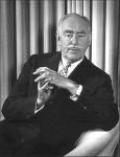Americans don’t hesitate to say anything they please about a public performance. But the right to do so wasn’t established until the Cherry Sisters sued a critic who didn’t like their appalling vaudeville act.
The year 1896 found Oscar Hammerstein in trouble. He was in debt, and the acts he had brought to Broadway weren’t doing well. He was desperate. “I’ve tried the best,” he is reported to have said. “Now I’ll try the worst.” So he sent for the Cherry Sisters.
Victorian art, collected for patriotism and profit, finds a home in a New York hotel 19
There is a stretch of some twenty blocks or so on upper Fifth Avenue known as Museum Mile, where art collections of every description fill former turn-of-the-century mansions that have been converted into galleries open to the public.
To Vaux and Olmsted the entire park, with its crags and cascades and meadows, was a single work of art, minutely planned and painstakingly executed.
In the dead center of the long, rectangular island of Manhattan—New York to most people—sits a long rectangle of parkland known appropriately enough as Central Park.
The restaurant that changed the way we dine—
When Charles Dickens first came to the United States in 1842, he did not like our clothes, our speech, or our manners. But he reserved perhaps his deepest scorn for our dining habits.
said a New York newspaper when the Metropolitan opened its American Wing in 1924. This spring, a new, grander American Wing once again displays the collection that Lewis Mumford found “not merely an exhibition of art,” but “a pageant of American history.”
The reopening of the Metropolitan Museum’s American Wing this spring deserves the great attention it is likely to get.
During the spring of 1801 Charles Willson Peale learned of a remarkable discovery—the huge bones of an “animal of uncommon magnitude” had been found in Orange and Ulster counties north of New York City.
Of the skyscrapers that sprang up in American cities in the early years of this century and embodied in masonry and steel the swaggering vitality of American technology and American business enterprise, none took so firm a grip on the public imagination as th
At fifty-eight years of age, Roscoe Conkling was still a strapping figure of a man, proud of his strength. The former senator, presidential aspirant, and kingpin of Republican politics in New York State neither smoked nor imbibed. He exercised and boxed regularly. So when William Sulzer, a young lawyer who had an office on the same floor as Conkling’s in a Wall Street building, could not find a cab, Conkling decided to leave for his club, two and a half miles away, “on my pins.”
COPYRIGHT © 1976, WHITNEY MUSEUM OF AMERICAN ART
Mile for mile, it cost more in dollars—and lives—than any railroad ever built
It was not long after the completion of the Panama Railroad in 1855 that Bedford Clapperton Pirn declared with perfect composure that of all the world’s wonders none could surpass this one as a demonstration of man’s capacity to do great things against imposs
No other impresario ever matched the record of the indomitable Max Maretzek in bringing new works and new stars to America
He was called “the indomitable Max,” “the indefatigable Max,” “the hardy pioneer,” “the Napoleon of Opera.” About that Napoleonic designation Max Maretzek himself disagreed.
Miriam Follin had a penchant for diamonds, the demimonde, and the dramatic. She also possessed the business acumen to become one of America’s leading publishers in the nineteenth century
Riflemen lined the roofs along the parade route. Cavalry squads patrolled the intersections.
IT’S A PETRIFIED MAN!
IT’S A SEVENTEENTH-CENTURY IDOL!
IT’S A HOAX!
ITS THE CARDIFF GIANT!
One morning in early November of the year 1868 three men appeared at the railroad depot in Union, New York, just outside Binghamton.
“It is needless,” wrote his publisher, “to say anything of the writer of ‘Maple Leaf,’ ‘Cascades,’ ‘Sunflower’ or ‘Entertainer.’ You know him.” But this black genius died penniless and all but forgotten
Scott Joplin, riding high in the early flush of his success, wrote the jaunty words on the preceding page for a song that he fashioned in 1904 from his sensational piano rag hit of 1899.
How a champagne picnic on Monument Mountain led to a profound revision of Moby Dick — and disenchantment
A little group of American men of affairs and letters met along with their ladies on the morning of August 5, 1850, to hike up Monument Mountain, one of the more prominent features of the landscape surrounding Stockbridge, Massachusetts.
It moved more boys and girls than the Children’s Crusade of the Middle Ages—and to far happier conclusions
Among the thousands of homeless children deposited at the Children’s Aid Society in 1875 by orphan asylums, courts, and other institutions was a four-year-old named Willie, sent by the New York Prison Association.
A visit to New York when it was little, not very old, and rather more attractive
New York during the Revolution was, a loyalist wrote, “a most dirty, desolate and wretched place.” And indeed it was. No other American city suffered as much from the war.
AN IMPRESARIO NAMED HAMMERSTEIN SET HIS SIGHTS ON TUMBLING AN INSTITUTION CALLED THE MET
The curtain of the Manhattan Opera House rose for the first time at nine o’clock on the night of December 3, 1906.
Thus Boss Richard Croker breezily dismissed charges of corruption. But the fortune he made from “honest graft” was not enough to buy him what he most wanted
The most glamorous and the most powerful of the Tammany bosses who ran New York City for much of the century between Boss Tweed and Carmine DeSapio was Richard Croker.
Ever since 1792, bulls and bears together have tripped the light fantastic on Wall Street’s sidewalks—and sometimes just tripped
On a cold Saturday in December, 1865, the 350 members of the New York Stock Exchange gave a party to celebrate moving into a new building on Broad Street, near the corner of Wall—the first home of their own.
To his contemporaries Thomas Nast was unquestionably America’s greatest and most effective political cartoonist, attacking corruption with a brilliant and often vitriolic pen, harrying the bosses, creating the political symbols that still remain the emblems of our two major political parties.
One day in late October of 1864, as the Civil War was moving into its final stages, eight young men in civilian clothes arrived in New York City from Toronto by train.
The old gray mare was not the ecological marvel, in American cities, that horse lovers like to believe
To many urban Americans in the 1970’s, fighting their way through the traffic’s din and gagging on air heavy with exhaust fumes, the,automobile is a major villain in the sad tale of atmospheric pollution.
Every March 17 on Fifth Avenue shamrocks bloom, bagpipes skirl, and colleens prance prettily along. Begorra, it’s a great day for the Irish!
Columbia College presented a peaceful exterior in 1788, but inside its medical laboratories something strange was going on; and under cover of darkness freshly interred bodies were disappearing from nearby burying grounds
The 1910 race for the mayoralty of New York looked like a tough one.
Flags flew and champagne flowed when the Czar’s ships anchored in New York Harbor. Fifty years later we learned the reason for their surprise visit
The draft riots of 1863 turned a great city into a living hell.
New York received the great composer like a god; he responded con brio to its shiny gadgets and beautiful women and produced an “American” opera.





